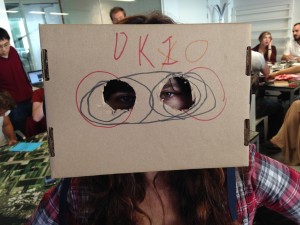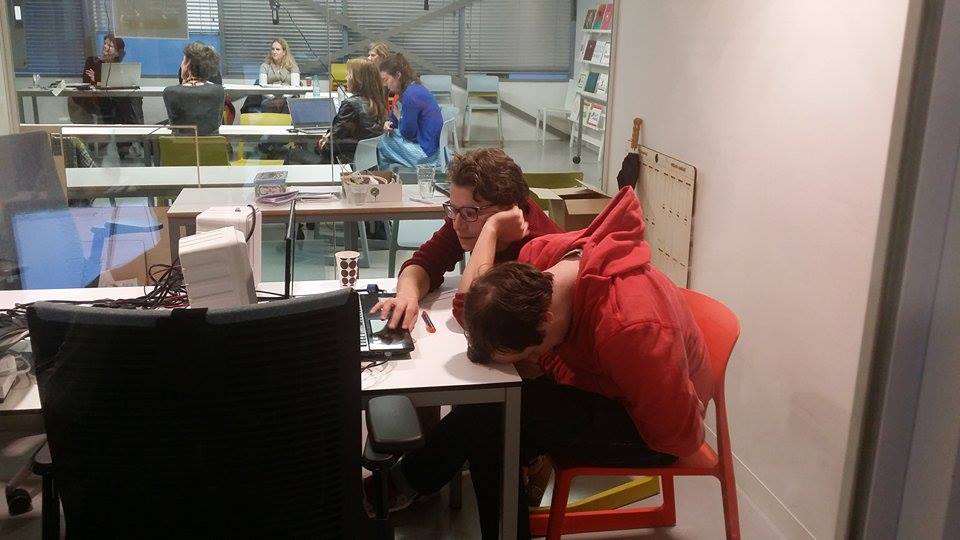When the Interactive Cinema project started in September we knew close to nothing about making a movie in virtual reality. There was almost no information to find, because nobody had ever done anything like this before. So during the making of our project, our team did a lot of research about how to create a virtual reality movie. To help future virtual reality moviemakers, we made guideline with all our discoveries. It is filled with tips and tricks about production, writing and shooting and available here:
InteractiveCinema_Guideline_v5
Our project made it into the newspapers a second time. The saturday edition of the Dutch newspaper Parool wrote a praising article about our premiere in VondelCS.

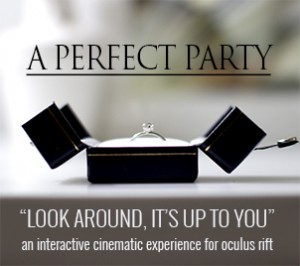
This Friday we had the premiere of our movie in VondelCS. WeMakeVR and the AVRO/TROS both invited a bunch people from the industry to experience our movie first hand. There were two Oculus Rift headsets showing our story.
For a lot of people this was their first virtual realty experience and most of them were very impressed with the fact that you could actually influence the storyline as a character.
On last Friday, we visited DocLab Expo: Immersive Reality. This program’s concept was described as follows.
We are immersing ourselves deeper and deeper in a digital reality, surpassing both our wildest dreams and our greatest nightmares. From the end of privacy to the future of storytelling, how do we redefine the documentary genre in the digital age?
We found that there were some similar points with our own project’s concept. Immersive Reality, especially for Oculus Rift projects, have gone really far on game production. We can find a lot of interesting and imaginative VR games on the internet. But experiments on actual world are not enough, we think.
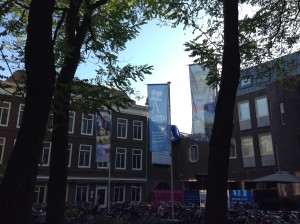
We experienced a few works on the expo. We’d like to introduce some projects that gave us inspiration.
Strangers with Patrick Watson
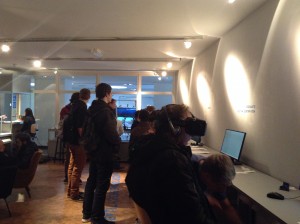
People can put on the virtual reality headset and feel as if you’re physically present in Canadian musician Patrick Watson’s Montréal studio loft on a crisp winter’s day. Without interaction provided for the user, this immersive documentary just gave us a very natural and comfortable experience. People will feel very relax with the live music inside.
The Machine to Be Another
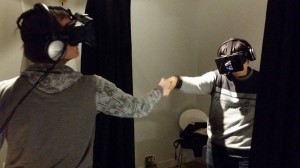
The Machine to Be Another provided a chance for a woman to experience having a man’s body, for a physically fit jogger to find out what it’s like to be wheelchair-bound, and for a black person to live in the body of a white person. This interactive performance installation is based on low-budget experiments such as first-person cameras, and Oculus Rift DK1, but it caused international uproar in experimental anthropology, gender studies and gay studies circles because it offers a totally new approach to understanding identity. The makers themselves are intensely ideological and see their machine as an instrument for boosting empathetic responses, making the world a better place in the process.
Assent
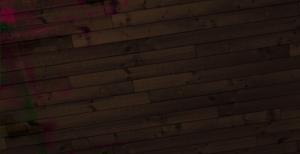
Oscar Raby’s Assent offers a moving immersive documentary experience that plays out in the virtual past. Through the Oculus Rift headset, media artist Raby transports the audience to a digital version of Chile in 1973. After a short introduction, you walk in the footsteps of Raby’s father. With him, you’re witness to an execution of a group of prisoners captured by the military regime – an army that Raby’s father was himself a part of. This work is a very good example to tell us how to use color in an immersive environment.
We finished Sprint 3 last week. During this sprint, we came up with 3 different concepts.
At the first step, we made a brainstorming of concept. We wrote keywords on post-it notes.
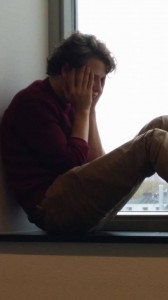
Then combined 2 or 3 keywords together in order to get some sparks.
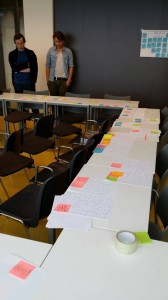
After that, We picked up 10 of the combinations and arranged each into one kind of plausible concept.
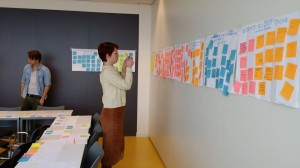
Then we came to 3 candidates. Palm Reader, A Brave New World and Time Traveller. We detailed these 3 concepts and even made 2 versions of each.
We used paper prototype to express our concepts and ask stakeholders and our friends to give us some ideas. Here are our 3 candidates.
Palm Reader
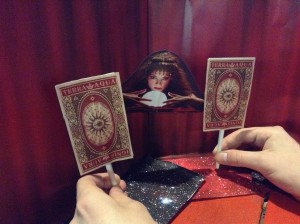
Palm Reader
The car breaks down and Mark is stuck with a woman that seems to know too much. She tells him she can help him with his car, on the condition that he lets her use some of his time. She convinces him that she is indeed a wise woman, and gives him the possibility to change his future.
A Brave New World
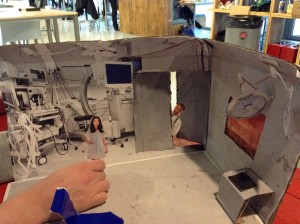
A Brave New World
The protagonist is locked up in a lab in a post-apocalyptic world. The doctor taking care of him uncovers irregularities with the information. During the course of the story, a nurse helps him figure out the information he need and get close to the truth.
Time Traveller
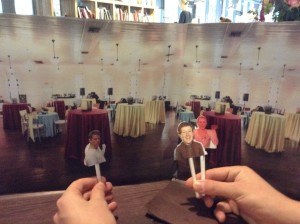
Time Traveller
Joe’s grandfather tells Joe his biggest secret. All the man of their family can travel in time. At first Joe is doubtful, but after he discovers it’s really true. He travels back in time to a new year’s eve party to win the heart of the girl he loves. He only has a couple of minutes to get her to like him, because she kisses someone else at midnight.
Finally, we decided to use a concept from Time Traveller. We are going to complete the story and get all preparation of film-shooting done during Sprint 4.
We had a script writing workshop at AVROTROS last Thursday. We got very precious advice about storytelling and filmmaking for virtual reality. Some ideas are really useful for the production of our own final project. We’d like to pick up some insights we need deal with and tips we got from this workshop.
- Come up with 4 camera positions, and the types of scene genre application they would be effective for.
Every camera position has its feature. In a VR movie, it’s not wise enough to use cuts as frequently as traditional movies. Normally, we need pick up one camera position as the main position. So we should consider about at least 4 camera positions and each one’s advantages. In that way, we could make a wise selection on camera position.
- Come up with ways to direct/influence viewer attention.
In a VR movie, audience can get 360° perspective. It is one of the most exciting feature of VR movie. But it also means that there are more possibilities for audience to lost their attention. We need to use various solutions to direct/influence our viewers’ attention.
- Based on “The Game”, what other existing movie or scenes in movie would fit/work within the “restrictions” of the VR-format?
We treat a VR movie as a kind of art form between traditional movie and video game. Work should be done to explore limits of VR movies and learn to fit.
- Plan for backup shooting days. (especially for outdoor film days)
- Location should be natural, small details can help a lot.
- Be careful with the time changing (light changing), all the shots are supposed to be in the same approximate time-frame.
- Synchronizing the frames.
We are now working hard on the story of our final project. These tips and insights are supposed to be used for our film-shooting.


During sprint 2, we did tons of research work and a user test on interactive storytelling. By using the user test, we tried to figure out the advantage and disadvantage of first, second and third person perspectives. Also we tried to find out pro’s and con’s on different story structures and visual effects.
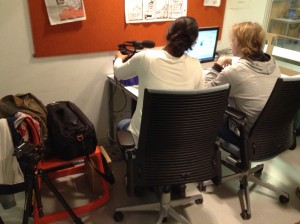
Preparation for user test
Besides these, we used hotspots in our demo movies. A hotspot is something that if you interactive with, you will receive an appropriate feedback. For example, in Date Scene, one of our demo movie, if you stared at sky when hearing somebody talking about the weather, it will turn to rain. We are going to use this idea to add interactive elements into our final project.
Depends on the result of user test, we found out that using visual effects in filmed footage is a good option, and timing of hotspots needs intricate planning. furthermore, sound setup for narration is not that technically demanding. We are trying to use these results to improve our final project’s user experience.
Today our Interactive Cinema project made it into the Volkskrant, a big Dutch newspaper. It’s even accompanied with a big picture of one of our teammates. The article talks about how our team is one of the first that’s experimenting with creating a narrative experience for virtual reality.
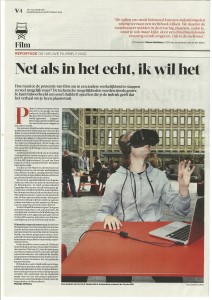
Today we had a workshop about tinkering and prototyping. We made a cardboard oculus rift and acted out a murder mystery scene. When the user put on our paper prototype, he was transported to our “virtual reality.”
We started out by asking our test subject to put on our paper prototype and then told him he was being transported to our “Virtual Reality”. Our test subject could activate certain characters in the scene by looking at them for a certain amount of time. The character would then relay a message regarding the murder. When our test subject heard all the messages, he had to point out the murderer. We found this to be a great way to test out scene’s for the Oculus and we will probably use it in the future.
Acting out the scene felt a lot like theater play. Theater is actually the medium that lies closest to virtual reality at the moment. It deals with a lot of the same problems, one of them being the freedom to look around you. It’s the director’s job to direct the attention of the audience to the desired location.
We will have to do the same thing in our VR movie, in order to prevent the user missing important events around him.
